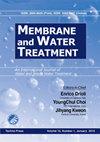应用于城市不同土地利用的污染物积聚模型分析
IF 1.1
4区 工程技术
Q4 ENGINEERING, CHEMICAL
引用次数: 3
摘要
本研究分析了污染物积聚模型在不同城市土地利用上的应用,并将城市地区的污染物积聚作为雨水径流污染的一个来源进行了表征。利用2008 - 2016年城市商业(8个点)、工业(10个点)、道路(8个点)、住宅(10个点)、娱乐(5个点)等不透水地表的监测数据,分析污染物积聚模型。结果表明,平均径流系数在0.35 ~ 0.61之间变化。除游憩用地外,所有用地的径流系数均在0.5以上,其中以商业区最高。商业用地是所有土地利用中污染物产生EMC最高的土地利用,与其他土地利用相比,被认为有必要进行NPS管理。商业区域的最大累积负荷为4.59 g/m2,道路区域的最大累积负荷为5.90 g/m2,而居民区域的最大累积负荷为0.40 g/m2和0.14 g/m2。根据土地利用方式和污染物参数的不同,污染物积累速率常数在0.1 ~ 1.3 1/d之间,即在旱季的1 ~ 10 d之间发生污染物积累。很明显,这些堆积曲线通常可以根据土地用途进行分类。前干日(ADD)是开发污染物积累函数的一个合适而合理的变量。不同土地利用方式的污染物积累曲线表明,污染物积累曲线可以根据土地利用方式进行总体分类。本文章由计算机程序翻译,如有差异,请以英文原文为准。
Analysis of pollutant build-up model applied to various urban landuse
This study was conducted to analyse the application of pollutant build-up model on various urban landuses and to characterize pollutant build-up on urban areas as a source of stormwater runoff pollution. The monitored data from impervious surfaces in urban areas such as commercial (8 sites), industrial (10 sites), road (8 sites), residential (10 sites), recreational (5 sites) from 2008 to 2016 were used for the analysis of pollutant build-up model. Based on the results, the average runoff coefficients vary from 0.35 to 0.61. In all landuses except recreational landuse, the runoff coefficient is 0.5 or more, which is the highest in the commercial area. Commercial landuse where pollutants occur at the highest EMC in all landuse, and it is considered that NPS management is necessary compared with other landuses. The maximum build-up load for organic matter (BOD) was highest in the commercial area (4.59 g/m2), and for particular matter (TSS) in the road area (5.90 g/m2) while for nutrient (TN and TP) in the residential area (0.40 g/m2, 0.14 g/m2). The rate constants ranged from 0.1 to 1.3 1/day depending on landuse and pollutant parameters, which means that pollutant accumulation occurs between 1 and 10 days during dry day. It is clear that these build-up curves can generally be classified based on landuse. Antecedent dry day (ADD) is a suitable and reasonable variable for developing pollutant build-up functions. The pollutant build-up curves for different landuse shows that these build-up curves can be generally categorized based on landuse.
求助全文
通过发布文献求助,成功后即可免费获取论文全文。
去求助
来源期刊

Membrane Water Treatment
ENGINEERING, CHEMICAL-WATER RESOURCES
CiteScore
1.90
自引率
30.00%
发文量
0
审稿时长
>12 weeks
期刊介绍:
The Membrane and Water Treatment(MWT), An International Journal, aims at opening an access to the valuable source of technical information and providing an excellent publication channel for the global community of researchers in Membrane and Water Treatment related area. Specific emphasis of the journal may include but not limited to; the engineering and scientific aspects of understanding the basic mechanisms and applying membranes for water and waste water treatment, such as transport phenomena, surface characteristics, fouling, scaling, desalination, membrane bioreactors, water reuse, and system optimization.
 求助内容:
求助内容: 应助结果提醒方式:
应助结果提醒方式:


